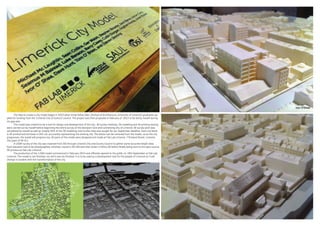StephenBourke_ArchPortfolio-min.2
•
0 likes•77 views
Three SAUL graduates received funding in 2013 from Limerick City of Culture council to create a 1:500 scale 3D printed model of Limerick City. The creator led the project during their gap year, completing the majority of the survey and 3D modeling work alone. The model accurately represents the existing city in removable blocks to allow it to progress along with changes to the city. It was created at Fab Lab Limerick to serve as a design and development tool for the people of Limerick.
Report
Share
Report
Share
Download to read offline

Recommended
How to use technology and big data to transform infrastructure planning and design for cities with AutoDesk. Presented by Paul McRoberts, AutoDesk, at Transforming Transportation 2014.Technology and Big Data - Transforming Infrastructure Planning & Design - Pau...

Technology and Big Data - Transforming Infrastructure Planning & Design - Pau...WRI Ross Center for Sustainable Cities
Recommended
How to use technology and big data to transform infrastructure planning and design for cities with AutoDesk. Presented by Paul McRoberts, AutoDesk, at Transforming Transportation 2014.Technology and Big Data - Transforming Infrastructure Planning & Design - Pau...

Technology and Big Data - Transforming Infrastructure Planning & Design - Pau...WRI Ross Center for Sustainable Cities
More Related Content
Similar to StephenBourke_ArchPortfolio-min.2
Similar to StephenBourke_ArchPortfolio-min.2 (15)
From Smart Cities to Responsive Cities: how to bring citizens back to the cen...

From Smart Cities to Responsive Cities: how to bring citizens back to the cen...
EDF2014: Talk of Frank Kresin, Research Director, Waag Society, Netherlands: ...

EDF2014: Talk of Frank Kresin, Research Director, Waag Society, Netherlands: ...
Snap4City November 2019 Course: Smart City API, federation, Web and Mobile Ap...

Snap4City November 2019 Course: Smart City API, federation, Web and Mobile Ap...
Vizerra - innovations in visual communications using games and VR&AR

Vizerra - innovations in visual communications using games and VR&AR
RV 2014: Online Tools + Transit Apps = 1 Unique Experience

RV 2014: Online Tools + Transit Apps = 1 Unique Experience
StephenBourke_ArchPortfolio-min.2
- 1. The idea to create a city model began in 2013 when three fellow SAUL (School of Architecture, University of Limerick) graduates ap- plied for funding from the ‘Limerick City of Culture’ council. The project was then proposed in February of 2014 to be led by myself during my gap year. The model was created to be a tool for design and development of the city. All survey methods, 3d modeling and 3d printing testing were carried out by myself before beginning the entire survey of the Georgian Core and connecting City of Limerick. All survey work was completed by myself as well as roughly 50% of the 3D modeling until further help was sought for our September deadline. Each city block is 3D printed and the base is CNC cut, accurately representing the existing city. The blocks can be removed from the model, so as the city progresses, the model will progress too. All parts of the model were designed and made at Fab Lab Limerick, 7 Rutland Street, Limerick City (part of SA UL). A LIDAR survey of the city was received from OSI through Limerick City and County Council to gather some accurate height data. Each elevation had to be photographed, stitched, traced in 2D CAD and then drawn in Rhino 3D before finally being sent to the open source 3D printers at Fab Lab Limerick. The production of the 1:500 model commenced in February 2014 and officially opened to the public on 19th September at Fab Lab Limerick. The model is not finished, nor will it ever be finished. It is to be used as a development tool for the people of Limerick so it will change in tandem with the transformation of the city.